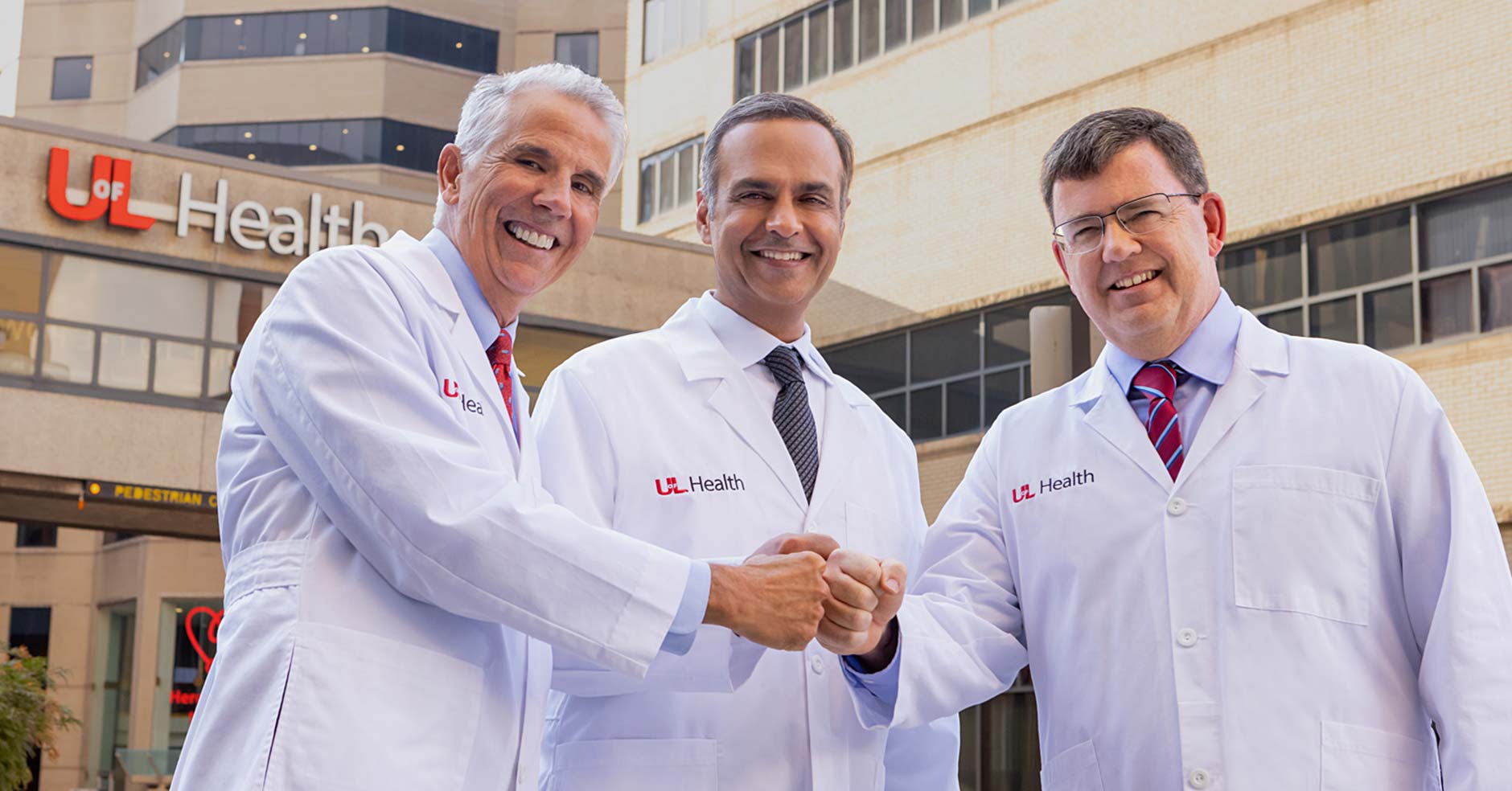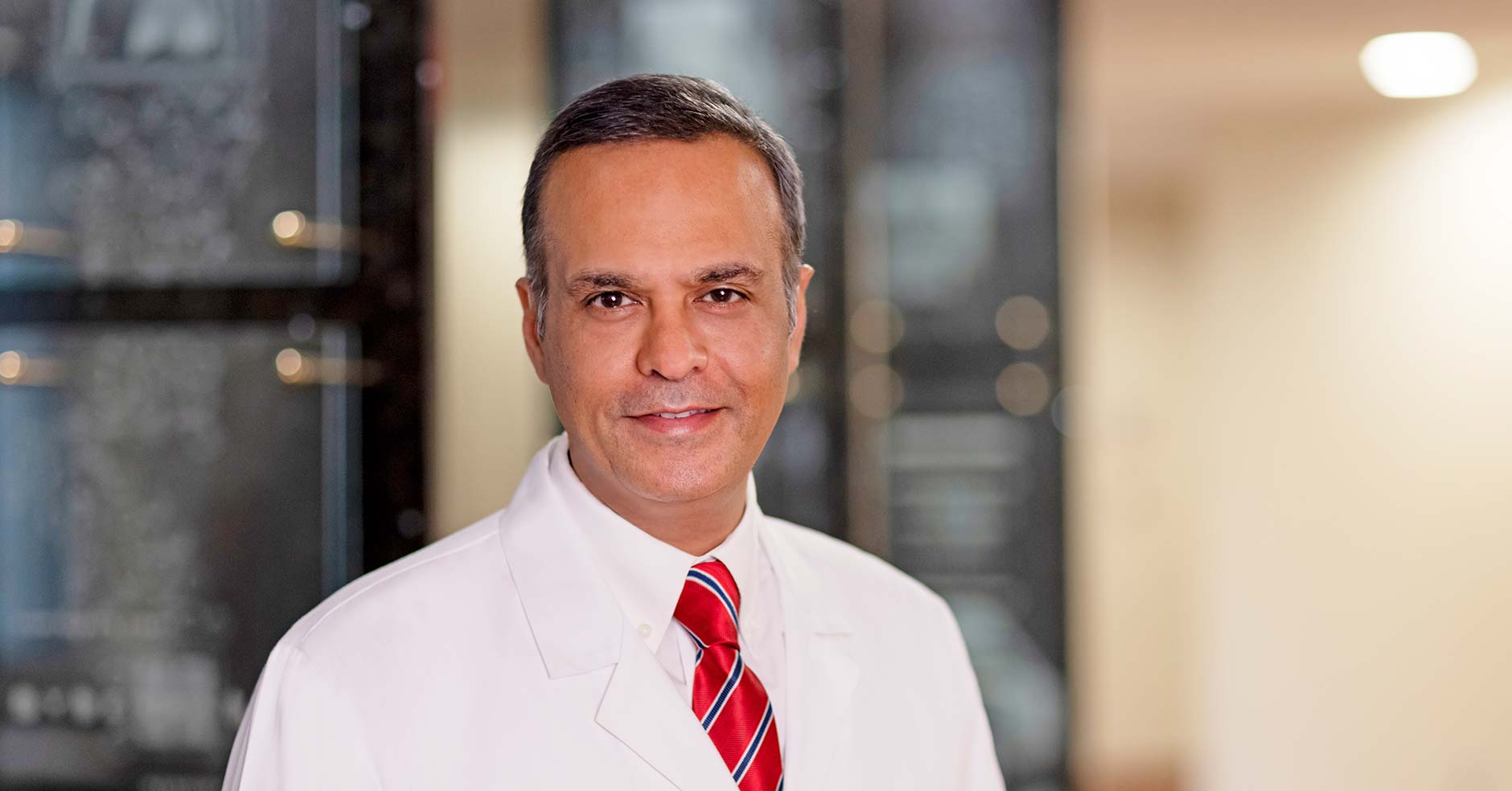A lifelong passion for cardiology and lipidology fuels Dr. Dinesh Kalra’s life-saving work
LOUISVILLE We all have that one thing that really gets our heart pumping, that piques our interest, that gains our undivided attention. For Dinesh Kalra, MD, ironically, that one thing has always been the heart. That is why he is chief of cardiovascular medicine at University of Louisville School of Medicine Division of Cardiology, a part of UofL Health.
Born in India, Kalra attended the All India Institute of Medical Science, the top medical school in India. He was one of 35 medical students selected from approximately 250,000 who took the entrance exam. Even before he enrolled, he knew where he wanted to specialize.
“I knew right from the get go I wanted to be a cardiologist,” says Kalra, who is also the governor elect of the American College of Cardiology, Kentucky Chapter. “I was fascinated by cardiology and especially cardiac imaging. Once I graduated, I looked around to see which programs were doing fantastic work in cardiology. I was very enthusiastic about Baylor College of Medicine in Houston where they were doing fascinating work in echocardiography.”
Kalra was accepted into the residency program at Baylor’s College of Medicine and went on to do a cardiology fellowship there as well, including a year in echocardiography. He continued with an electrophysiology fellowship at the University of Michigan and an advanced cardiac imaging fellowship at WeillCornell New York Presbyterian Hospital. He then worked in Boston and Chicago, where he started the cardiac imaging program at RUSH and built it into a Regional Center of Excellence. The University of Louisville School of Medicine was interested in building a similar program and recruited Kalra, who accepted and moved to Louisville in 2021.
“There was not a cardiac imaging program here,” says Kalra, who also is an endowed professor of cardiovascular innovations at UofL. “There was not a lipid clinic, despite Kentucky having a lot of problems with lipid and heart disease. They needed those holes to be plugged.”
Kalra began the process of plugging those holes immediately, embracing the goal of raising the quality and depth of care at UofL Health and research at UofL School of Medicine. That has meant taking on a demanding schedule that includes both clinical and academic duties. He sees patients in clinic one day a week and does in-patient rounding and cardiac imaging. He reads the majority of the cardiac CT scans, MRIs, and echocardiograms.
“I do teaching and administration, plus leadership and research,” says Kalra, who is vice chair of quality in the Department of Medicine. “This is a profession where you dedicate yourself to doing whatever it takes to better the lives of people and to help people around you. We have to get the institution to be a Regional Center of Excellence. This is a fantastic opportunity, and it would be sad to waste it.”
Bench to Bedside
Kalra says that being a university health system provides many opportunities to be at the forefront in medical care, research, and technology.
“You can be a fantastic community hospital that is giving state-of-the-art medical care, but you might be lacking on newest scientific innovations,” Kalra says, noting that the Division of Cardiology is participating in about 50 clinical trials. “You have the research component, the teaching component, and the clinical care component. We’re leading the forefront in terms of research and innovation, and that’s possible only because we have all of these three components.”
One of the areas being examined is the causes behind health inequities. Kalra and his team are publishing a paper in a cardiology journal that looks at the rates of cardiovascular screening of Caucasians versus ethnic minorities in UofL Health – UofL Physicians clinics. The results show that, for the same risk factors of cardiovascular disease, the minority patients are being screened at a lower rate by the same physicians.
“Not intentionally, but there are differences in the way different races are being screened and treated,” Kalra says. “One of my goals is to eliminate those disparities – not just eliminate them, but actually correct them. I don’t quite understand why there should be differences in an academic care environment, but research is looking at factors that lead to that and how we can appropriately educate our physicians as to correct that.”
Increasing the diversity among the medical personnel is also a priority, and Kalra proudly points out that UofL School of Medicine’s current medical class has more women than men and that the University of Louisville is “at the forefront across the country of supporting LBGTQ rights and encompassing diversity and inclusion in its ranks.”

The UofL Health Lipid Clinic
UofL Health is also at the forefront of the latest medical studies and advances. In addition to the many duties and titles held by Kalra, he is also the Director of Advanced Cardiac Imaging, Lipid Clinic & Infiltrative Heart Disease Program. Within the lipid clinic, Kalra says there are significant advances that more of his colleagues need to be aware of.
“In the past we only had statins to deal with high cholesterol,” he says. “Now we have about 14 or 15 different kinds of drugs to reduce cardiovascular risk. Unfortunately, most cardiologists – just because they haven’t specialized in lipidology – are not aware of many of these drugs. As the only lipid clinic in the region, we can take care of people with these complex lipid problems.”
Infiltrative Heart Disease
Kalra and his team are also well equipped to deal with the complexities of infiltrative heart diseases, such as amyloidosis, which was not recognized as an important heart disease until the last few years. Now, Kalra says, it is understood that 1 in 10 older people may be impacted by amyloidosis, which can result in heart failure.
“We are one of the specialized centers of excellence for these kinds of infiltrative heart disorders,” Kalra says. “These diseases are uncommon and not on the radar of many cardiologists. They are difficult to diagnose and treat. So, we have all the elements that are needed to diagnose and treat these patients.”
Kalra acknowledges that the innovations and discoveries in cardiology are coming at an increasingly rapid pace and that it can be difficult to keep up. “It’s really a time of explosive change in the world of cardiology, and I’m just amazed at the amount of discovery and innovation that is happening,” he says.
Holistic Approach to Patient Care
Among the discoveries that he would like more cardiologists to be aware of are procedures that are more effective treatments for blockages than some of the traditional methods, such as stents. It is a common misconception that cardiologists are essentially plumbers – finding the blockage and fixing it.
“The sad reality is multiple clinical trials have shown that fixing a blockage with a stent often does not extend a patient’s life or make them live any longer or feel better if they don’t have angina,” Kalra says. “Atherosclerosis is a systemic disease – you can’t play Whac-AMole. If you fix an 80 percent blockage, the patient can still have a heart attack because another 20 percent blockage that you ignored will rupture and cause a heart attack. We take a more holistic, scientific approach to a heart disease. Instead of focusing only on the problem once the damage has occurred, we try to prevent the problem in the first place. Quit mopping the floor again and again. Turn off the faucet. I’m not saying stenting is always wrong, but it’s become widely applied, indiscriminately to asymptomatic people.”
The many advancements, trials, and new drug options often result in multiple different courses of treatment in cardiology or any other medical specialty. That, says Kalra, is why it is so important to treat each patient as a unique individual case, which means getting to know them.
“Technology has definitely improved the world, but there’s a certain element in medicine that requires the human touch and presence and compassion, which will never be replaced,” Kalra says. “Unless I know more about this individual and understand them on a personal level, I am not able to fix them appropriately. The clinical space when I’m sitting next to a patient is sacrosanct – it’s our opportunity to bond and for them to see me as somebody who cares about them. Medicine to me is a holy calling and an art. It is a blessing and a charge and I take it very seriously.”
Kalra, you might say, takes his profession to heart.


